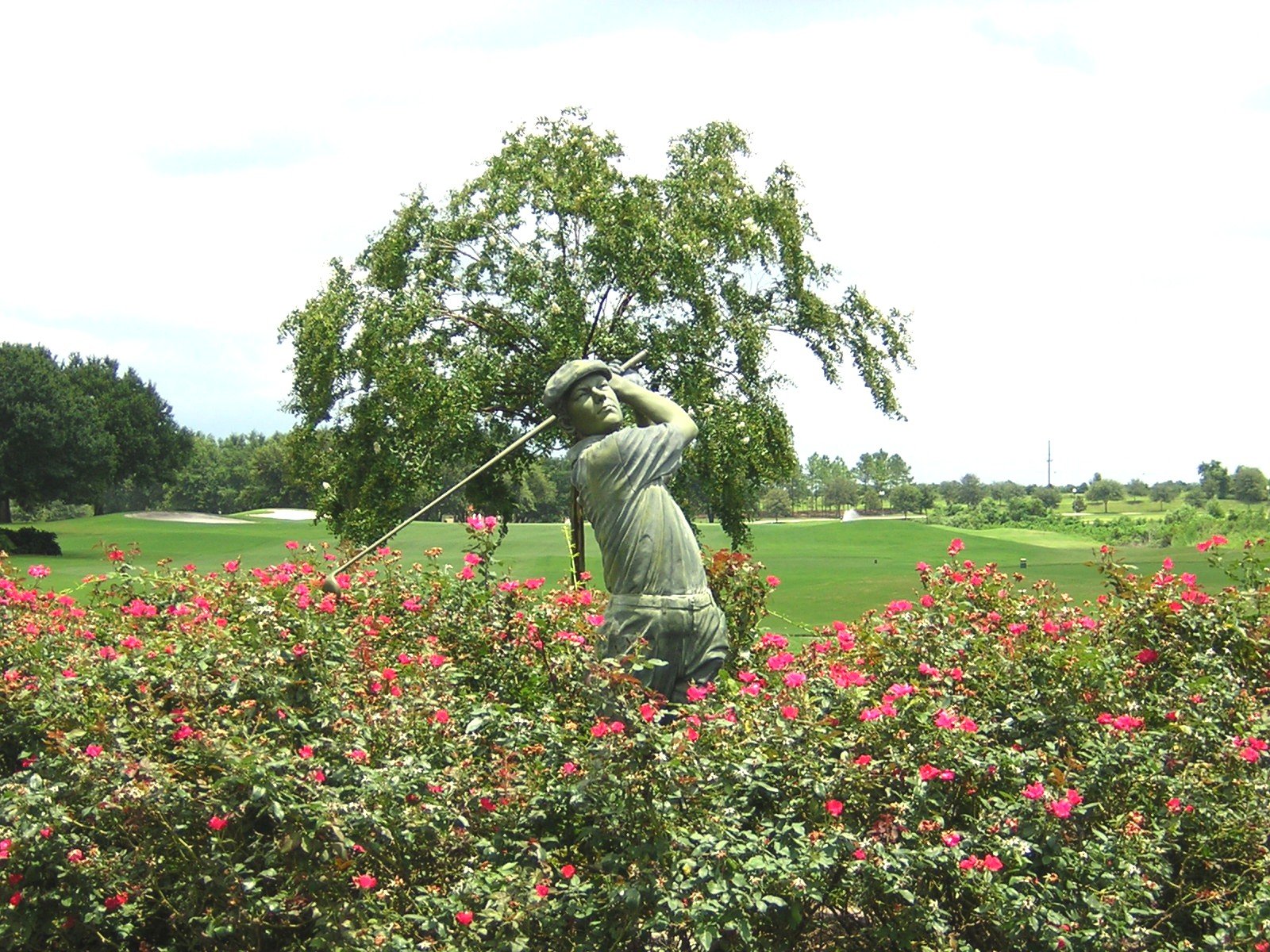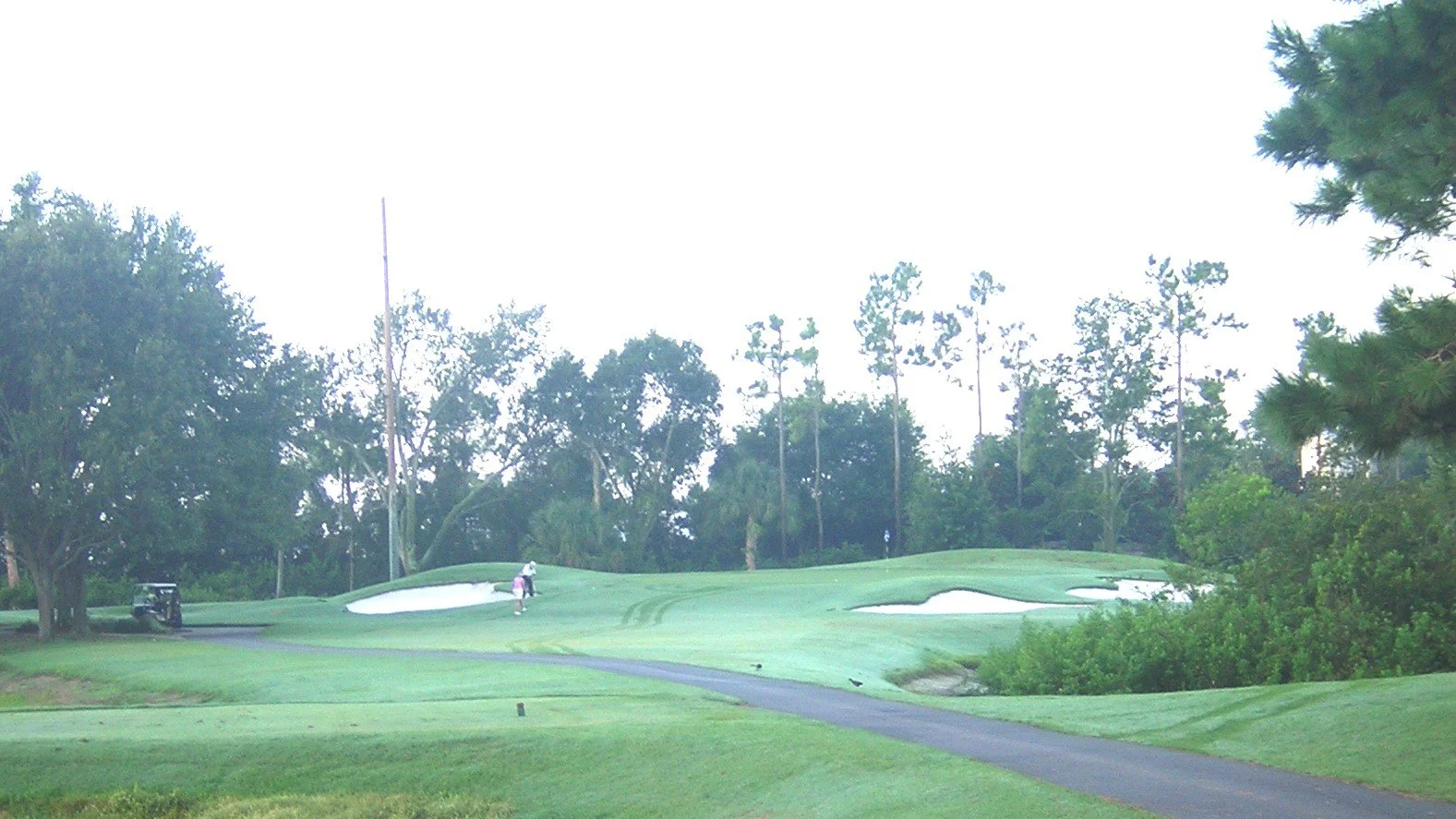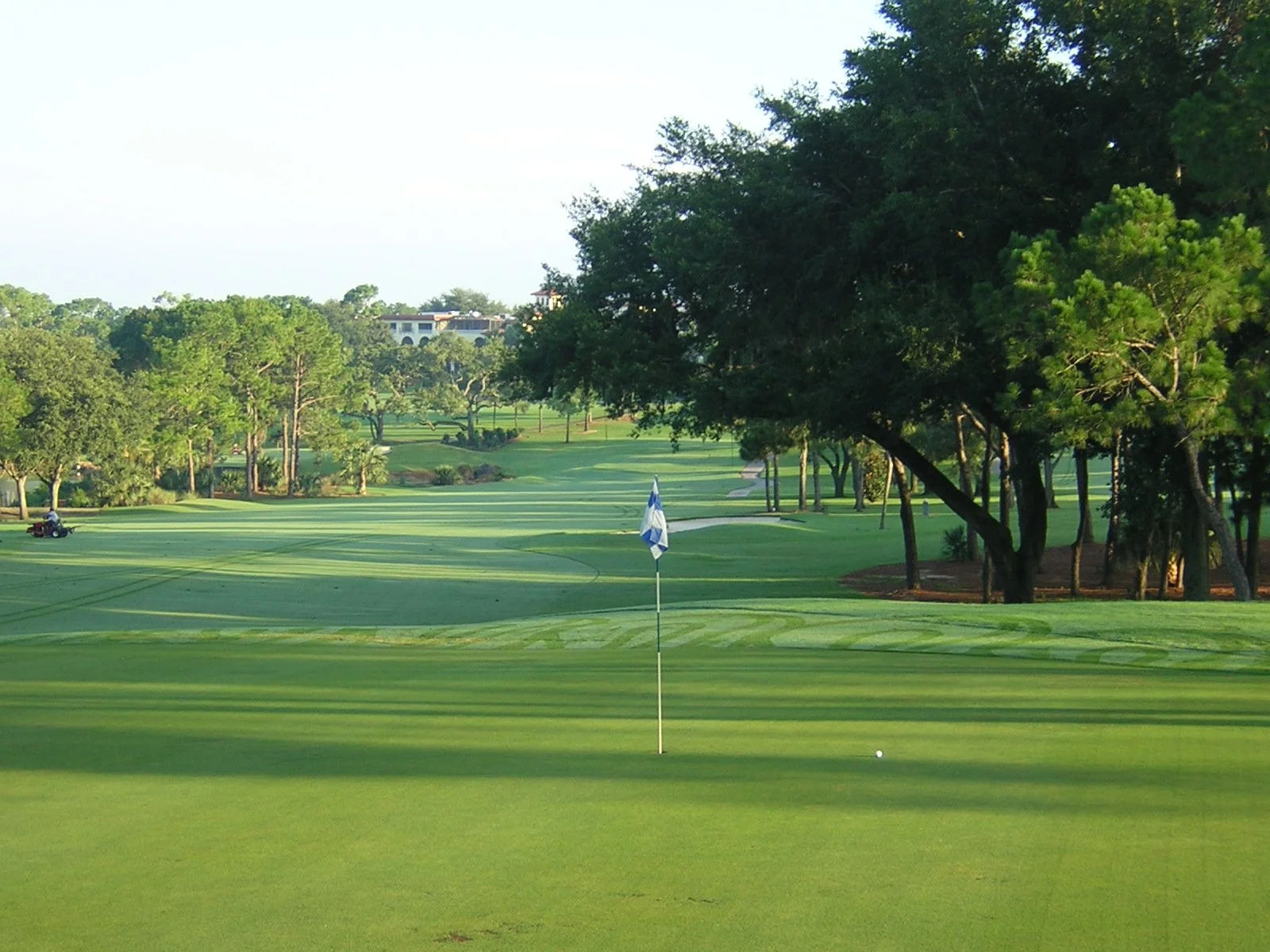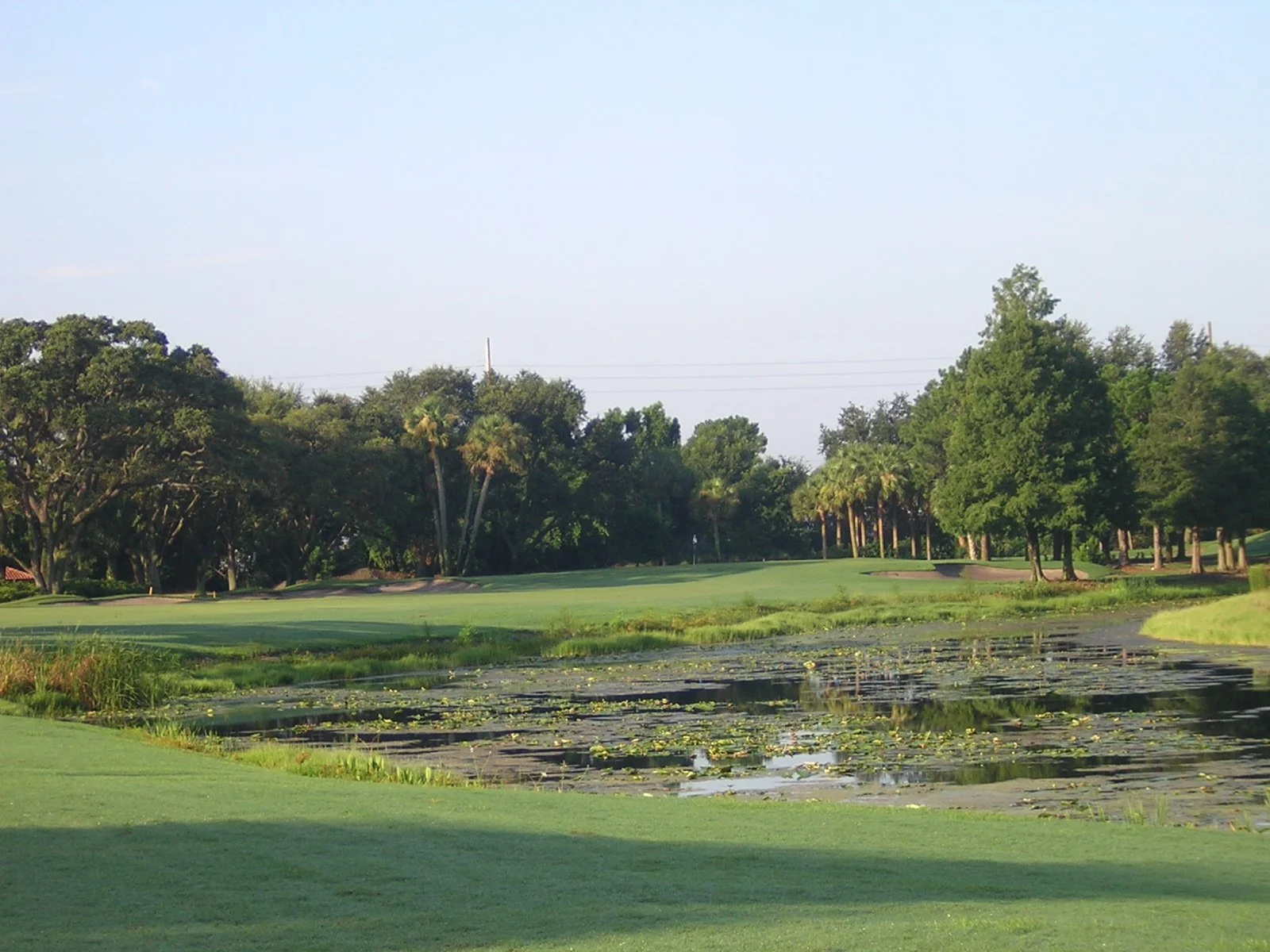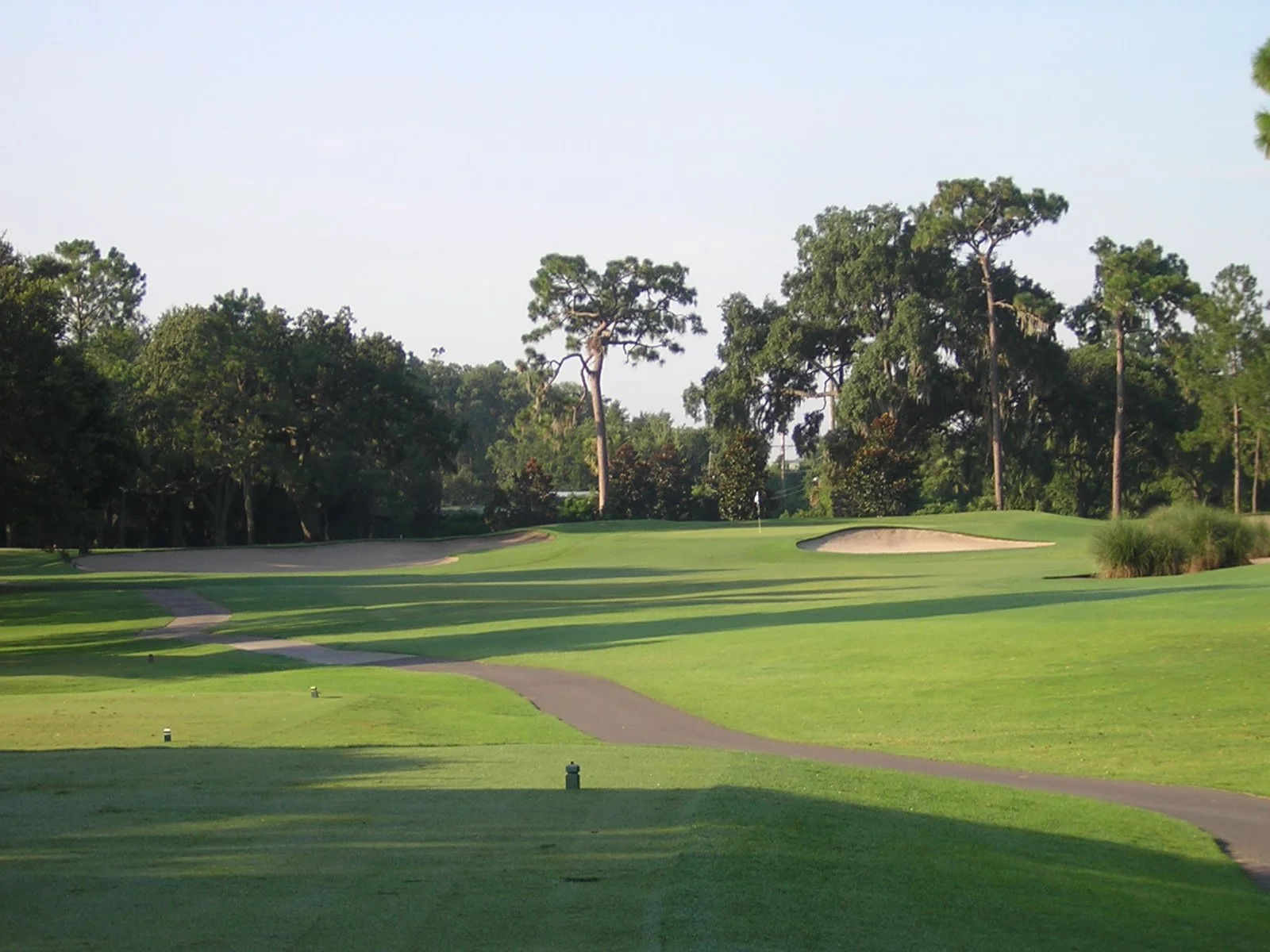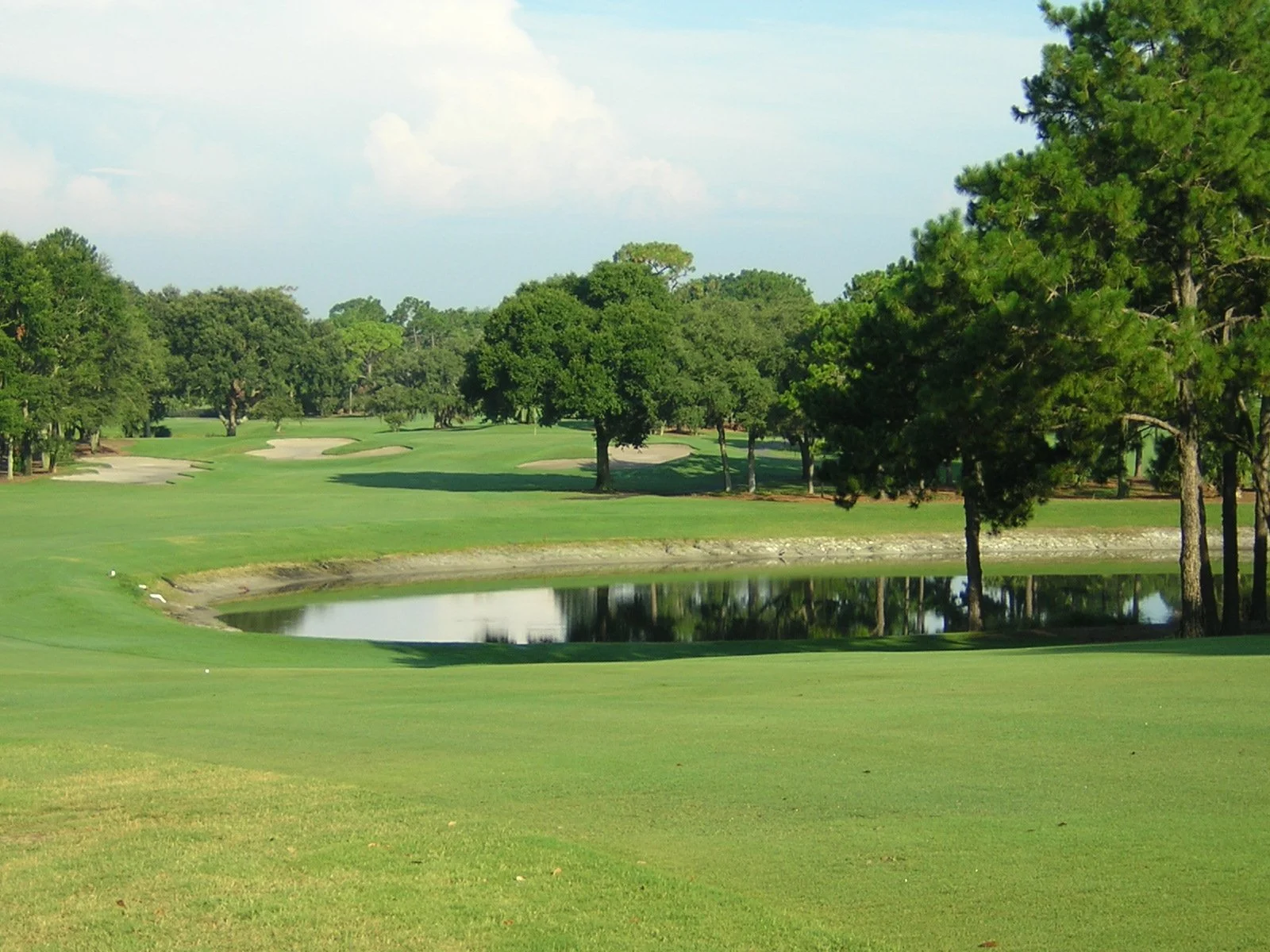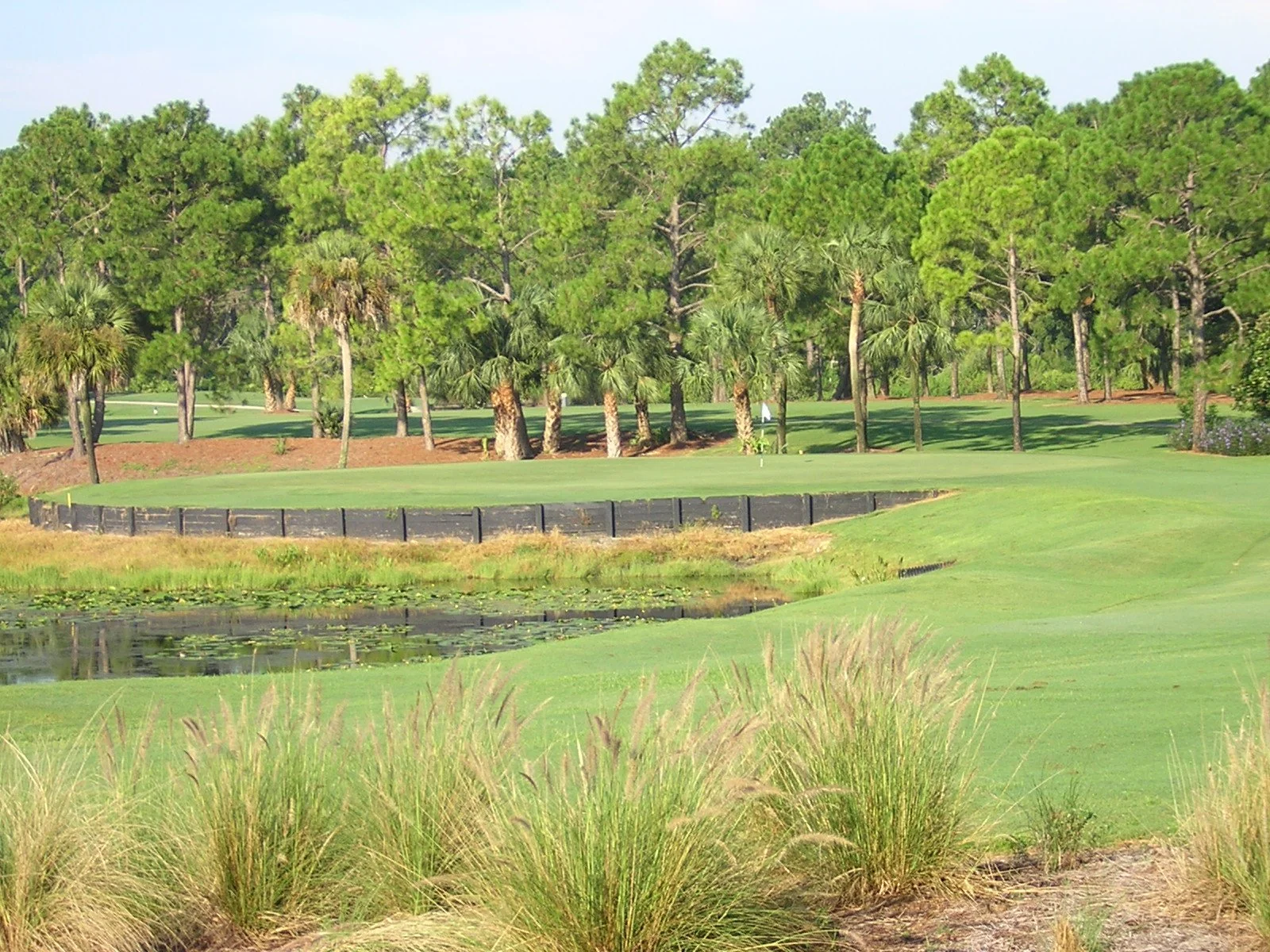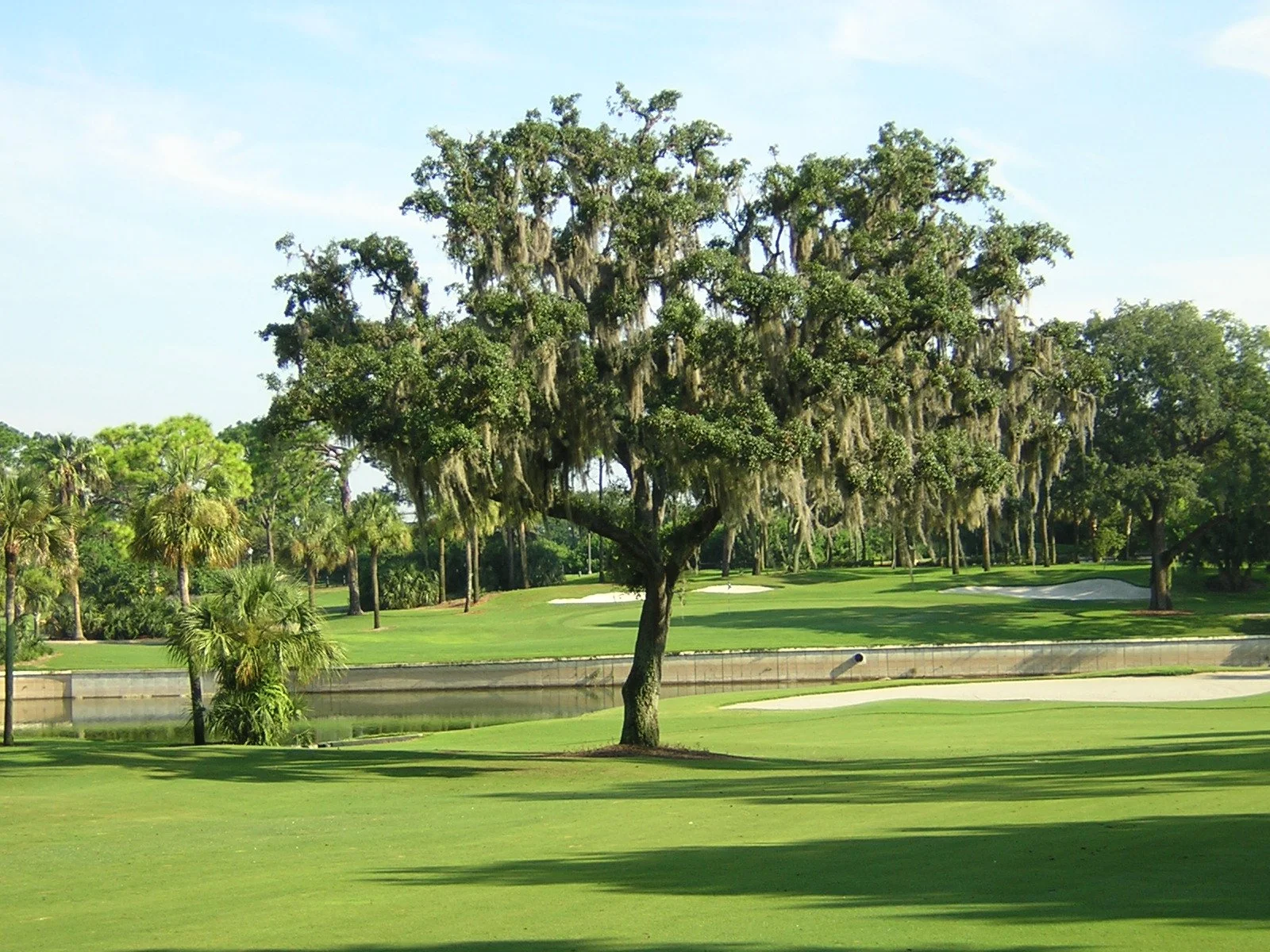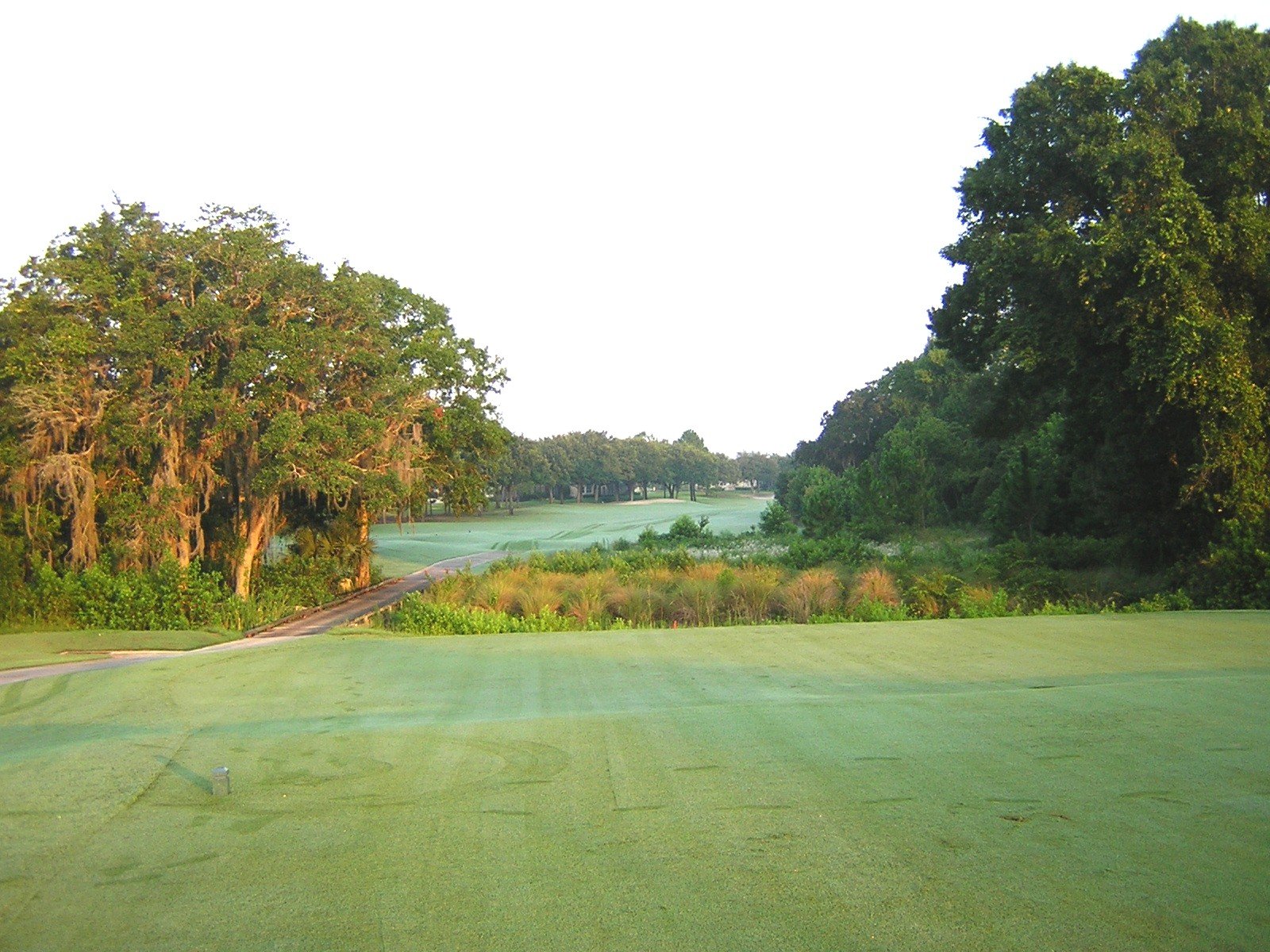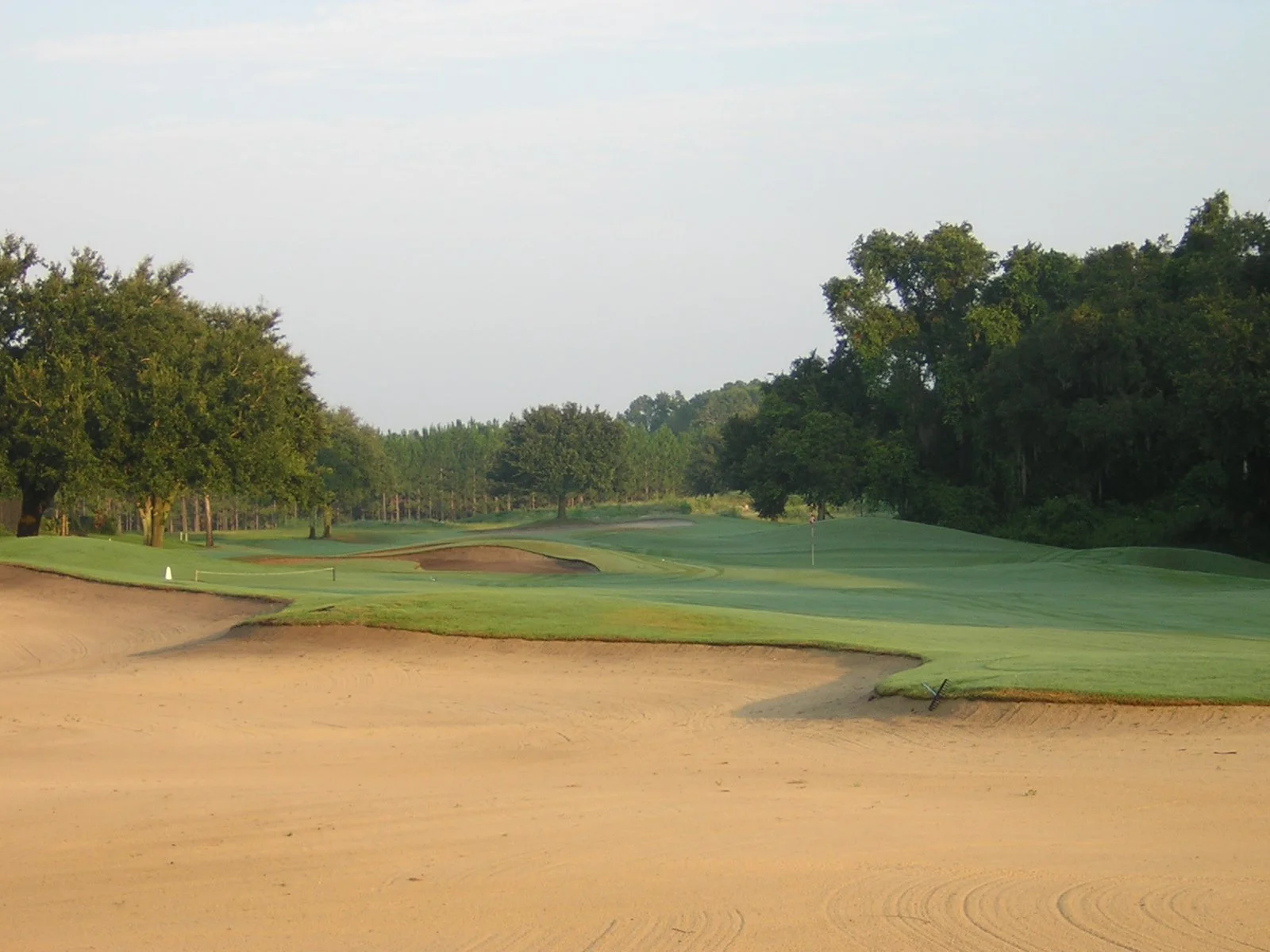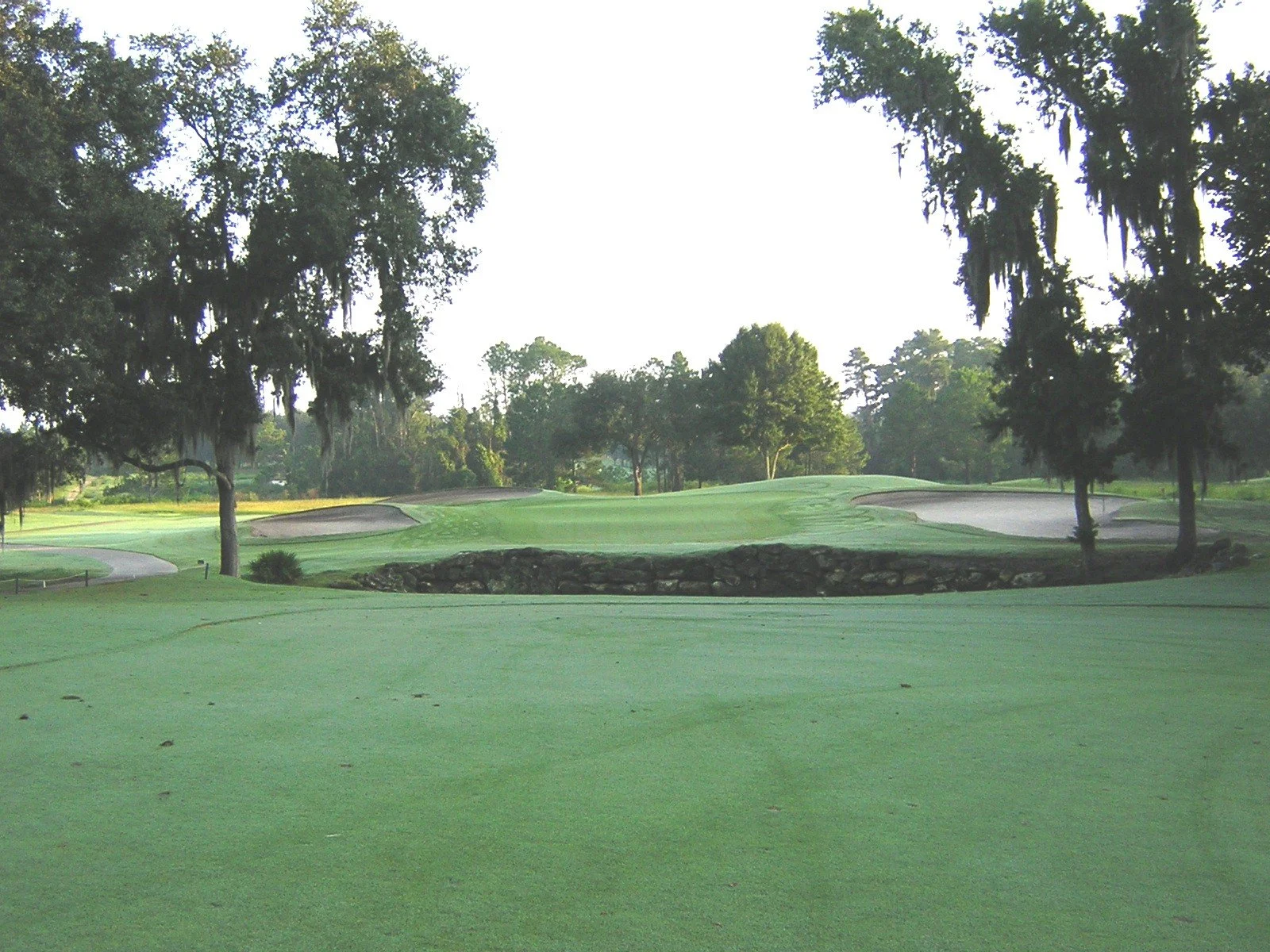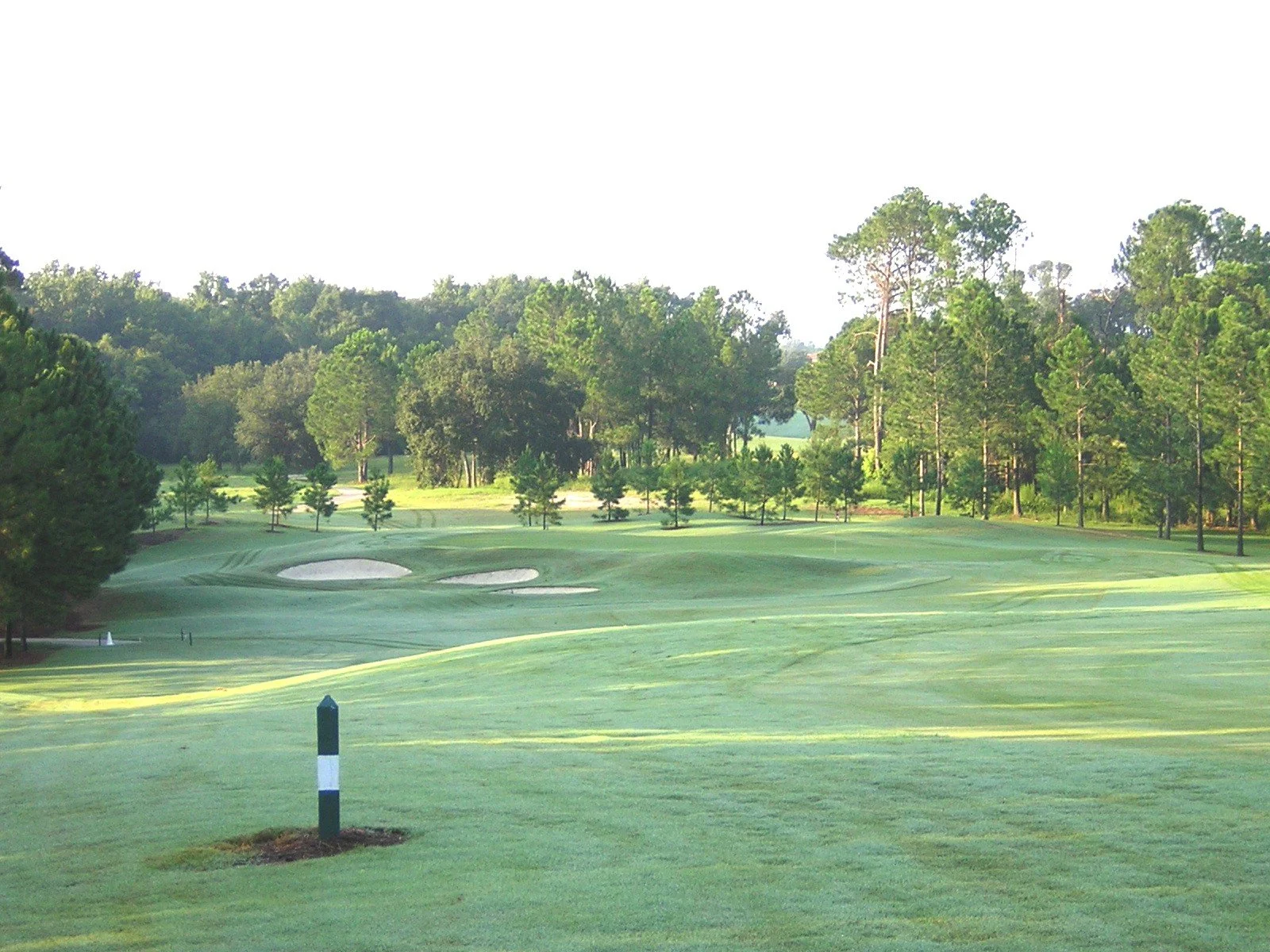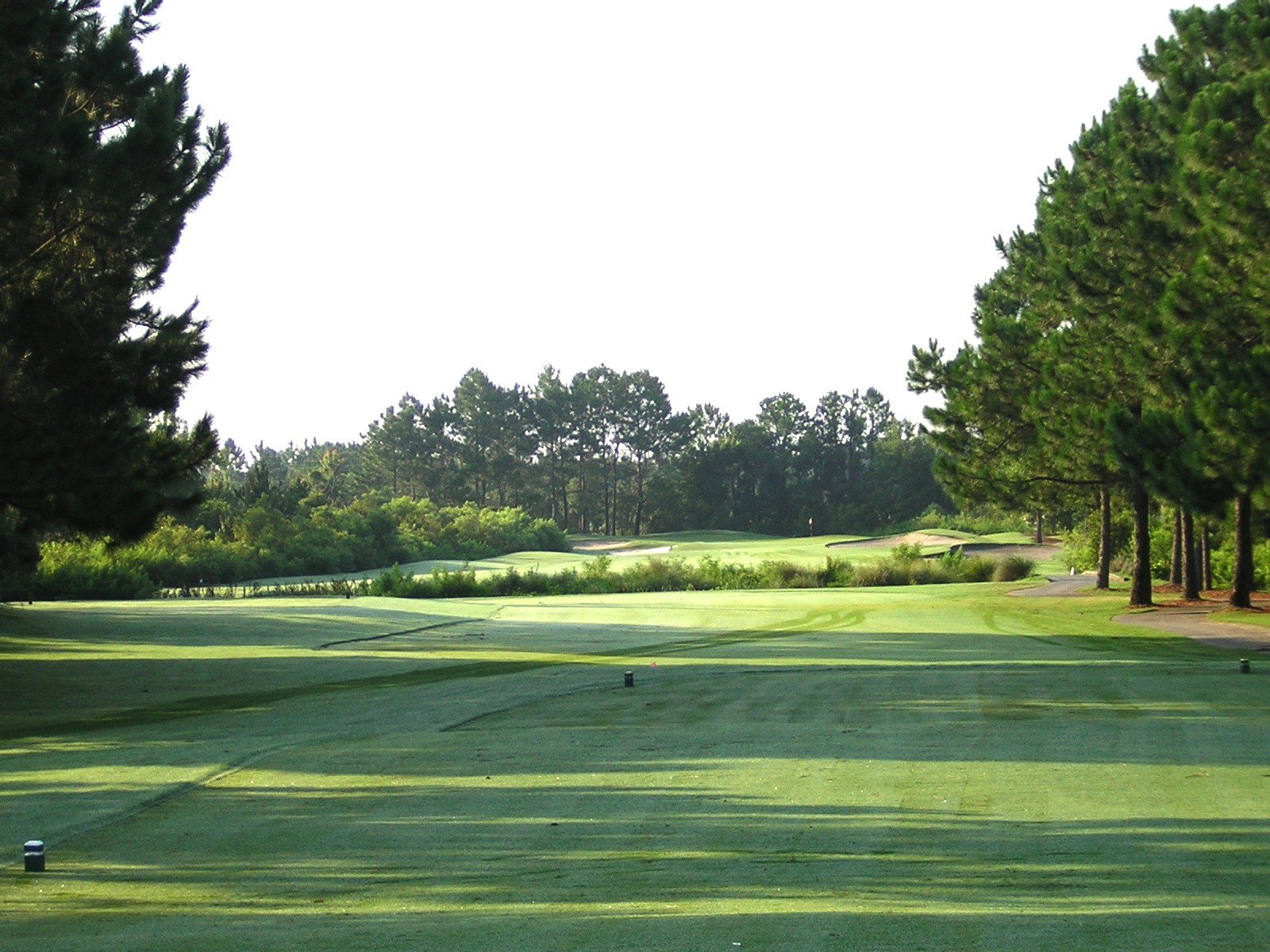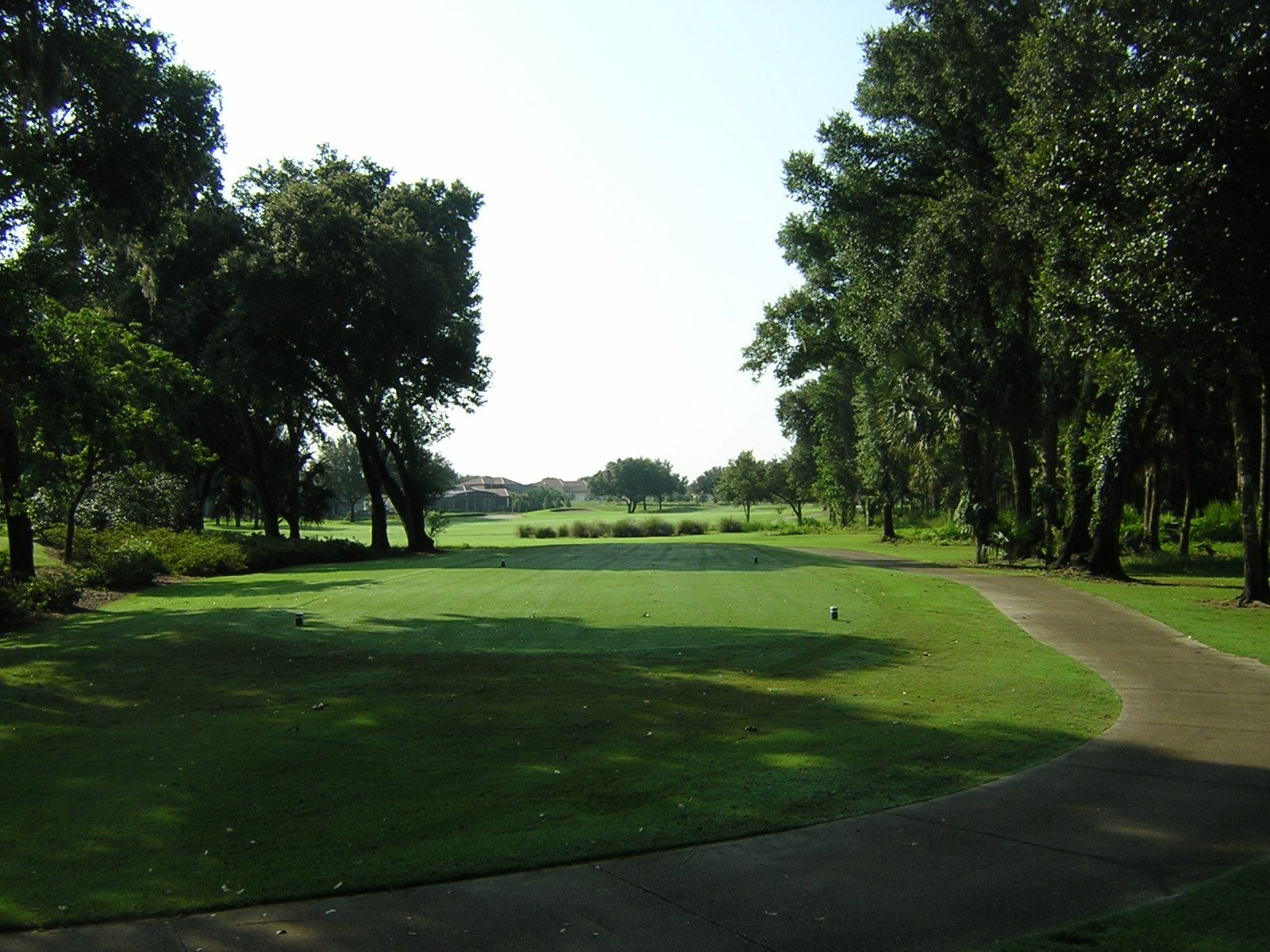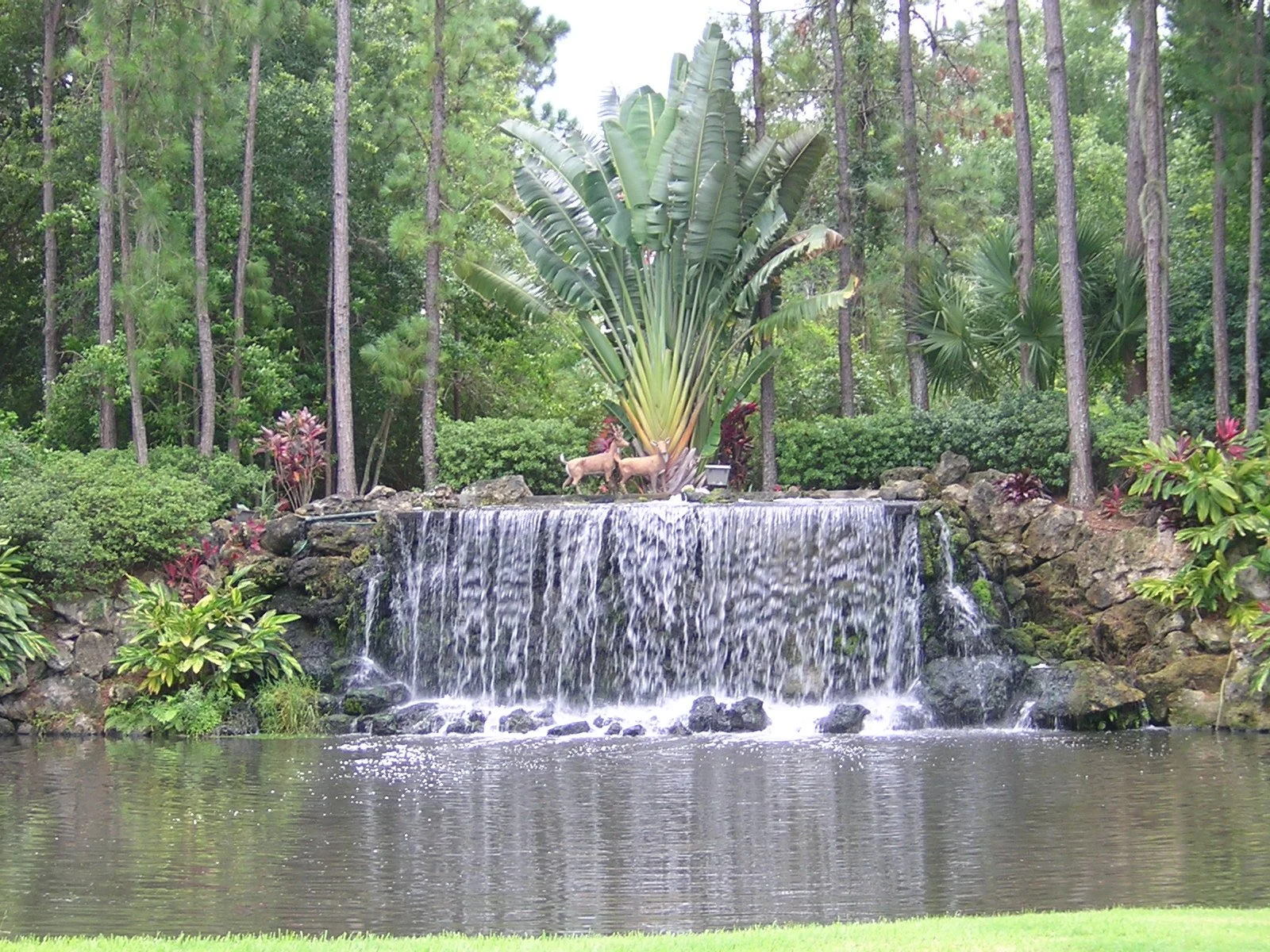MISSION INN RESORT
El Campeón Architects: George O'Neil (1917), Charles E. Clark (1926)
Year Opened: 1917
Location: Howey-in-the-Hills, Florida
Slope: 136. Rating: 74.2
Par: 72
Yardage: 7,003
Hole-by-Hole: 1 - Par 5 515 Yds 10 - Par 5 569 Yds
2 - Par 3 176 Yds 11 - Par 4 431 Yds
3 - Par 4 460 Yds 12 - Par 3 240 Yds
4 - Par 4 405 Yds 13 - Par 4 340 Yds
5 - Par 4 450 Yds 14 - Par 5 532 Yds
6 - Par 4 398 Yds 15 - Par 3 142 Yds
7 - Par 4 457 Yds 16 - Par 4 370 Yds
8 - Par 3 190 Yds 17 - Par 5 556 Yds
9 - Par 4 349 Yds 18 - Par 4 423 Yds
Par 36 3,400 Yds Par 36 3,603 Yds
Key Events Held: NCAA Division III Women's Golf (1997, 1999, 2006-07),
NCAA Division II Men's Golf Championship (1998, 2002),
NCAA Division II Women's Golf Championship (2003),
NCAA Division III Men's Golf Championship (2005-06),
Hooters Collegiate Match Play Championship (2004-05),
Florida Junior Golf Championship (2009).
Awards Won: 4 Stars by Golf Digest - Best places to Play (2006-09),
America's Top Golf Courses - Zagat (2006-08),
Links Magazine - Top 100 Golf Courses,
Ranked #10 in Florida - Florida Golf News.
Las Colinas Architects: Gary Koch (1992), Michelle Bourgeois/Mission Inn
(Renovation and redesign, 2006-07)
Year Opened: 1992
Location: Howey-in-the-Hills, Florida
Slope: 139. Rating: 75.5
Par: 72
Yardage: 7,217
Hole-by-Hole: 1 - Par 4 396 Yds 10 - Par 4 415 Yds
2 - Par 3 206 Yds 11 - Par 3 216 Yds
3 - Par 4 439 Yds 12 - Par 5 493 Yds
4 - Par 4 432 Yds 13 - Par 5 584 Yds
5 - Par 5 500 Yds 14 - Par 4 497 Yds
6 - Par 3 193 Yds 15 - Par 3 236 Yds
7 - Par 4 393 Yds 16 - Par 4 420 Yds
8 - Par 4 440 Yds 17 - Par 4 416 Yds
9 - Par 4 380 Yds 18 - Par 5 561 Yds
Par 35 3,379 Yds Par 37 3,838 Yds
Awards Won: 3 1/2 Stars by Golf Digest - Best places to Play (2006-09),
Best New Resort Course - Golf Digest (1992),
America's Top Golf Courses - Zagat (2006-08),
Top FairWays Award - Golf for Women.
Web site: www.missioninnresort.com
HISTORY: When people talk about the state of Florida, Spanish explorer Ponce de León certainly comes to mind, with his search for the mythical "Fountain of Youth" back in the early 1500s. Further conversations about the "Sunshine State" mostly circulate around Walt Disney and the Magic Kingdom, but it should be noted that in 1916, Illinois businessman William John Howey put
Florida on the map, so to speak.
With his purchase of 60,000 acres in Lake County, just north of Orlando, Howey created a horticultural and citrus empire, as the orange industry began to grow. The town's original name was "Howey," as it was incorporated in 1925, but just two years later, the name was officially changed to Howey-in-the-Hills, reflecting the area's rolling hills and brilliant lakes.
"The Florida Alps," as Mr. Howey penned, encompassed a region rich in sandy soil and wonderful drainage, and was almost frost free due to the 100 square miles of fresh water lakes. The bottom line - a perfect area for the orange crop and the first citrus juice plant built in Florida in 1921.
In 1924, Howey built the Hotel Floridan, a 75-room social hub that served as the centerpiece of the region and was used to house Northern investors and dignitaries. With the region rapidly growing, Howey, who served as mayor from 1925 to 1936, commissioned Charles E. Clarke from Troon, Scotland to design a golf course for recreation and for growth.
Clarke, revised the original work of Chicago golf architect George O'Neil, who is credited with crafting the first course at Mission Inn, El Campeón or "The Champion." Consistently ranked in the top-10 of Florida's courses, the resort's original layout makes it the fifth-oldest resort course in the state.
Due to the collapse of the Florida land boom in 1926, followed by the stock market crash in 1929 and the subsequent Great Depression of the 1930s, Howey's dreams came to a crashing end. During this time, Howey ran unsuccessfully for Governor (1928 and 1932) on the Republican ticket. Despite passing away at the age of 62 and never seeing his dreams come to fruition, Howey is to this day known as Florida's greatest citrus developer.
As the years passed and the citrus industry began to rebound, Nick Beucher stepped in and purchased the Floridan Country Club and Golf Course after responding to a 1964 ad in the Wall Street Journal. Beucher's Chicago-based company was a brokerage business that bought and sold cattle by-products worldwide for meat, feeds, and hides for leather.
Over the years, the course and clubhouse began to deteriorate and Beucher spent most of the 1950s renovating and redesigning the facility. The expansion of the clubhouse and the installation of an automatic irrigation system, as well as the planting of hundreds of trees, brought the course up to standards.
Beucher was not satisfied and by 1969, he created a Spanish-style golf resort, complete with all the amenities, changing the name to Mission Inn Resort & Club.
Mr. Beucher and his family have poured their heart and soul into the resort over the years and to this day, continue to take Mission Inn to the next level.
In 1992, former PGA Tour player Gary Koch was awarded the task of designing a second championship layout at Mission Inn. Koch, a six-time winner on Tour and television golf analyst, has designed several courses in Florida and around the country, but Las Colinas was his first. Named the "Ambassador of Golf" by the Governor of the State of Florida, Koch crafted a challenging and rewarding layout that received accolades right out of the box, as it was nominated for "Best New Resort Course" by Golf Digest.
Originally at 6,876 yards, Las Colinas (The Hills) was redesigned and renovated the past couple of years and now stretches to 7,217 from the back markers. Florida-based Ron Garl was originally brought in, but the true renovation and redesign work is credited to Michelle Bourgeois and the Mission Inn staff.
"We actually eliminated five holes and built five new holes," commented Director of Golf, John Viera Jr. "The holes that were affected on the front nine are the sixth and seventh and on the back nine, holes 13 through 15. I was very pleased with the addition, because we were actually able to eliminate a couple of holes that I thought could be improved on. I think it really enhances the Las Colinas golf course."
"There was a parcel of property that used to be a fruit farm that became available and was butting up against our property," added Viera. "So the (Beucher) family decided to purchase that and when they did, the land planners came in and decided to restructure the development of the Las Colinas
property, so that's what inspired the movement of the holes."
The NCAA has made frequent stops at Mission Inn Resort over the years, as it has played host to the Division II and III Championships since 1997. The 2004 Hooters Collegiate Division I Match Play Championship was also staged at Mission Inn, as Duke, led by current LPGA star Brittany Lang, captured the title over Arizona State. Lang, who won her final three matches, defeated another up-and-coming star, Louise Stahle, in the finals. Worth mentioning, Lang tied for second as an amateur at the 2005 U.S. Women's Open.
Mission Inn Resort has been expanded over the year to include three restaurants, two lounges, a poolside Cabana, 30,000 square feet for banquets, meetings and weddings, but the Pièce de résistance are the beautifully maintained accommodations. The property, which now encompasses 1,000 acres, features 190 guest rooms, suites and villas located in three distinct settings - La Posada de San Miguel, La Posada de San Diego and La Posada de San Angel.
REVIEW: EL CAMPEON COURSE - The opening hole is a sensible par-five of just 515 yards. Reachable in two, the key is the tee ball, which must skirt the inside of the right trees. If laying up, play down the left side to set up a simple wedge to a very accessible green. Sand guards the putting surface left and deep, while water right can capture the occasional misfire.
Playing slightly uphill, the second is the first of four outstanding par-threes. The putting surface is just 26 paces deep and slopes from back to front. A pair of traps guard the right, while one massive bunker flanks the left. Stay below the hole for your best shot at birdie.
The longest par-four on the course, the fourth is a bear of a hole doglegging left to the tune of 460 yards. A mound down the left side of the fairway will repel balls towards the center, which will leave a 200-yard poke to one of the flattest greens on the course, not to mention one of the smallest (22 yards). This hole can be conquered, but the tee shot will be key.
Playing straight uphill, the fourth plays much longer than the 405-yard length indicates. Even with a big drive, you'll have a blind shot with a long-iron to a severely sloped, back-to-front green. Trees down the right and left shadow the fairway, while sand right and left guard the green. This hole plays
significantly harder than its predecessor.
Another long par-four, the fifth plays downhill towards the fairway, reaching a length of 450 yards. The fairway is quite generous, however a pair of traps down the right will definitely come into play. Even with the downhill slope, a medium-iron will remain to an elevated and well-guarded green. One of the smallest on the course, the putting surface is a minuscule 19 paces in length and is guarded on either side by a pair of very deep bunkers. A ridge in the center of the green, can make for a difficult birdie try, but four is not a bad score.
Running alongside the fifth, the next hole plays back uphill to the green. One of just four par-fours under 400 yards in length, this gem bends slightly to the left and requires an accurate tee ball. Take an extra club or two to reach the putting surface or you'll end up in a diabolical bunker fronting the
green. The promised land slopes hard from left to right, so below the hole is key. I should know, I had a four-foot birdie putt above the hole and failed to scare the cup.
With a beautiful view of the region, the seventh is the hardest hole on the front side. Stretching 457 yards from the black, elevated tees, this monster requires a big shot down the right. Water dissects the fairway at the 270-yard mark, so three-metal is probably the play for the bigger hitters. With trees guarding both sides of the landing area, you'll need to be precise. With a medium-iron, your next shot will have to split a pair of traps that guard the long and narrow green. The two-tiered putting surface is 30 paces deep, so make sure you take enough stick.
The El Campeón course has many holes that can be considered as signature, but none more than the beautiful, par-three eighth. It's 190 yards of carry over water to a two-tiered green that slopes towards the lake. Bail out is to the left, as water surrounds to the right. Two bunkers guard the left and rear, just in case you're not man enough to take dead aim. I tried, but failed miserably.
Probably the easiest hole on the course, the ninth is but 349 yards with a slight bend to the left. Three-metal will set up a wedge to a very modest green. Although sand guards both sides of the putting surface, this hole is a green-light special. Just remember to avoid the two fairway traps and you're home free.
The longest hole on the course, the 10th is a great, risk-reward par-five. Doglegging sharp to the right, you'll have no problem hitting the wide landing area off the tee, however you must stay down the right side, which brings the lake into play. A successful tee ball will allow the player an opportunity to reach the promised land in two, however crossing a watery grave is never an easy task. The green is small and guarded on the right by sand, but should yield plenty of birdies. Your's truly wasn't as fortunate, but I did manage par.
Reminiscent of the third, the 11th is another long, dogleg left par-four. You'll need to stay clear of the left side, as this will block you from getting home in two on this slightly uphill, 431-yarder. One of the few holes on the course without a greenside bunker, the putting surface is small and slick and falls off sharply on all sides. The rough around the green is thick and gnarly, making for a difficult up and down.
You'll need to step on it to reach the par-three 12th green. 240 yards from the back markers and plenty of sand left and right. The putting surface is benign, but 31 paces long, so club selection is crucial.
After a break on the "valley holes," the course rises once again on the short, par-four 13th. Just 150 yards will clear the lake in front of the tee box, but too far down the fairway could result in landing in one of the four fairway bunkers. Playing straight uphill, you'll need at least one extra club to reach
the small putting surface. This green is without a doubt, the fastest on the course, as it runs from back to front. A rangefinder from the landing area goes a long way.
Hitting out of a chute of trees, the 14th plays downhill towards a narrow fairway and then bends hard to the right. Beware of the lake on the right, which is reachable off the tee. Out of position off the tee will force a layup down the left side, but one must avoid the 30-yard bunker, not to mention the trees on the right. With a wedge in hand, attack, attack, attack.
The final par-three on the course is also the shortest, at just 142 yards. Unprotected, the elements will certainly come into play, as you attempt to reach the short, but wide putting surface. Not much slope to the green could produce a few deuces.
Three of the finest holes on the course remain as you reach the 16th. All three can be considered signature holes. The fairway on the short par-four 16th is extremely generous. Devoid of sand, but not trouble, as water lurks down the entire left side and completely surrounds the green. Not only does water engulf the green, but the putting surface is 95-percent encompassed by a ring of sand. The green is not difficult to read, but it's just 24 paces in depth, so accuracy with your approach is a must.
Called "The Devil's Delight," the 17th is a wicked, 556 yard, double-dogleg par-five. A slight fade off the tee is recommended, as you must avoid the bunkers down the left side with the hole bending to the right. Cutting the corner is risky, as a tall tree to stands in your way. Laying up is the proper
play with water fronting the green. A medium-iron down the right and inside the tree and bunker line will set up a straight shot to the green. Too far back will leave a difficult shot over a fairway tree to the green. A wedge played left over the water must be spot on, as the green is only 21 paces deep
and severely sloped from back to front. To bunkers deep will snare any long shots and will leave little or no hope for par. It comes as no surprise, as this is the No. 1handicap hole.
The closer is a bear and not because of the length. Yes, it's 423 yards, but it also plays directly into the wind and your tee shot, depending upon how brave your are, must cross a good chunk of a lake. An aggressive line will force the player to bomb a 265-yard blast from the tips just to reach the
landing area. The smart play is just inside the left fairway bunkers, leaving a mid-iron to a green guarded by sand and water. The putting surface is long and lean and falls off sharply on the right towards the water. What a great finish!
LAS COLINAS COURSE - One of just three par-fours on the course under 400 yards, the first hole is great starter, as it eases you into your round. Enjoy the moment, since the second is a bear. Back to the opener, this straightaway hole features a wide fairway with a pair of traps down the left and water on the right. You'll have to miss by a lot to reach the H2O, but anything is possible. A short-iron will remain to a fairly large putting surface with a pair of bunkers on the left. The green is lightly sloped, so take advantage and make birdie.
Quite a contrast when you reach the second tee, especially from the tips. A rugged 206-yard par-three over water with a handful of pot bunkers in the rear. How this is rated the easiest hole on the course is beyond me. Make sure you take enough club, as the hole plays longer than the yardage indicates. I wish I knew back then what I know now. Double-bogey is not the way to start your day.
It becomes quite evident when you reach the third hole that the driver will become one of the most important clubs in your bag at Las Colinas. The first of seven 400-plus par-fours, the third stretches 439 yards and bends to the right with trees flanking both sides of the fairway. A fade off the tee is the
recommended play, as this will set up a medium- to long-iron to a well-guarded green. The putting surface is angled to the right with a trio of traps in the rear and a grass bunker on the right that sits well below the promised land. At 29 paces, this is one of the smallest greens on the course.
Bending slightly to the left, the fourth is another 400-plus par-four that requires a slight draw off the tee. You must avoid the trouble down the left in the form of sand, sand and more sand. A short- to medium-iron will remain to a green that slopes from left to right with a pair of traps on the left. This two-club putting surface can be had if the pin's up front.
The fifth is certainly a risk-reward par-five. Just 500 yards in length, you'll need to shape your tee ball from left to right, as the hole bends sharply. Avoid the pair of fairway bunkers and you'll have a shot, however, beware of the pond fronting the green, not to mention the towering trees on either side of the water. The smart play, lay up short of the water and trust your wedge game. The putting surface features three levels and is one of the longest at 41 yards in depth. Three gaping traps guard the green, but with a wedge in hand, go for it.
At 193 yards, the sixth is the shortest of the four par-threes on the course and it's the only hole at Las Colinas without sand. So where's the beef? A mid- to long-iron is needed to reach the undulating putting surface, that's fronted, short-left by a pond. Granted, the water should not be in play, but any mishit will certainly splash. The green is long and features a difficult drop-off on the left.
One of the few blind shots on the course, the tee shot on the seventh must go over a slight rise in the fairway, leaving a downhill approach to a well-guarded green. The split landing area runs out at 275 from the tips, so three-metal for you big bombers might be the club of choice. Just a short-iron
remains to a green that angles from right to left and is just 29 paces. Three sand traps and one grass bunker flank the left, making a back-left pin very difficult.
It will be a lengthy cart ride to the eighth hole, as you ponder what might have been and what will be. A robust par-four stretching 440 yards, this slight bender to the right plays longer that the yardage indicates. Your tee shot plays uphill towards the narrow fairway, which is tightly guarded on the right by sand and trees. Once past the initial trouble, you're left with a long-iron or fairway-metal to a long putting surface guarded on left by sand and right by water. A back-right pin and you're flirting with disaster.
Accuracy is the key on the ninth, a short, but tight 380-yard par-four. Playing straightaway, use your hybrid to splice the tree-lined, marsh-lined and bunkered fairway. This will leave a short-iron to a long, narrow green guarded on the left by sand. One word of caution, do not miss long or right, as thick brush and marsh await the slightly errant shot. Yes, I know by experience.
The opening hole on the back nine is a rather benign par-four that bends slightly to the right. The fairway is generous, but two bunkers at the 260-yard mark, pinch the landing area. Out of bounds left will certainly catch your eye, but the trees right are no bargain either. The green is long, but
sublime, with sand right and rear.
Another stern par-three, the 11th is 216 yards of pure carry over water to an undulating green. Open to the elements, this gem could be quite tricky when the wind is up and the pin is back-right. Worse case scenario, enjoy the wildlife around the lake.
The only hole completely surrounded by trees, the 12th is nicknamed, "Alligator Alley." Winding through the forest and marshy area, this somewhat reachable par-five is very tight and must be played with extreme caution. Leave the driver in the bag and play with a hybrid or fairway-metal. Even your layup will have to negotiate the tall oaks on either side of the landing area. Too far right and you're approach to the green will be blocked. The small, kidney-shaped putting surface is gentle, so if you have 100 yards for your third, attack!
Back-to-back par-five's, the 13th is the longest hole on the course. Playing uphill from the tee, blast away to the wide fairway, just stay clear of the 80-yard trap on the left. Your second is uphill as well, but no trouble to speak of, however the closer to the green, the tighter the landing area. The real test here is the putting surface, which features two tiers that slopes from back to front. Despite its No. 1 handicap status, this is a real birdie hole.
In contrast, the 14th is the hardest hole on the course by far. A sharp, dogleg left par-four, this monster necessitates length and accuracy. A high draw from the box will leave a long approach to a pipe-shaped green with a deep trap guarding on the right. This is one tough puppy.
The longest and most difficult par-three on the course, the 15th is almost unfair. At 236 yards, you'll need to shape your shot from the left to avoid the overhanging trees on the right. The green is circular with sand front and rear. By the way, any mishit left will end up in jail, as deep underbrush
awaits. "There was one green that we kept from the original design, but now you actually play to it from a different angle, that would be the 15th hole. It looks like an entirely different golf hole," said Viera.
If you thought you were out of the woods, you guessed wrong. The 16th is another dogleg par-four, this time to the right that requires a big, left to right pop through a chute of trees. Sand through the fairway will surely get your attention, so try a hug the right side. A mid- to long-iron will suffice to a green guarded right by a grass bunker and deep by the powdery stuff. Short and left is not a bad miss. At least you'll have a chance to get up and down.
One of the prettiest holes on the course, the 17th is a rock-solid, straightaway par-four of just 416 yards. The real test comes first with the tee ball, that must find the fairway. A deep and long bunker occupies most of the right side, while a humungous lake lays left. Although you're left with a
mid- to short-iron, you'll have to contend with the water left and a deep bunker fronting the wide, tiered green. A back-left pin can make matters very difficult.
The closing hole at Las Colinas is a long par-five, the third on the back nine, that requires accuracy off the tee. Although devoid of sand, the fairway is tight with mounds and trees right and left. You'll have little chance of reaching the marsh from the tips, however the other tee boxes will force you to think twice about which club to use off the tee. Favor the left side for your second shot, as marsh awaits down the right. The putting surface bends slightly to the right of the fairway, with sand front, left and rear. Once again, the green is two-tiered and with a back-right pin, it could add another 15 yards to your approach.
FINAL WORD: When you discuss central Florida as a vacation and golfing destination, Orlando and Disney World usually go hand in hand. Well, let me tell you, that's not the only game in town.
Mission Inn Resort and Club is not to be overlooked.
First of all, it's just 40 minutes from Mickey and Minnie. Second, the two 18-hole championship golf courses are such a pleasant change from the new wave of architecture in golf design.
"Character of these courses is what makes the Resort so outstanding," mentioned Assistant Professional Randall Noonan.
That's just for starters. As stated earlier, the spectacular accommodations are sensational. From deluxe hotel rooms to one and two-bedroom suites and villas. The Posadas overlook the golf course, tennis courts and the sparkling lakes.
Restaurants and lounges are at your fingertips, such as the elegant La Hacienda, complete with a 22-foot ceiling and an open fireplace. Whether it's Sunday brunch or prime rib and seafood buffet night, the fare at Mission Inn is quite delectable.
There's tennis, fishing excursions, horseback riding, even hot air ballooning, but the real catch at Mission Inn is the golf.
The El Campeón is the standard for golf in central Florida. Beautifully manicured grounds, rolling fairways and distinct bunkering, unusual and welcomed elevation changes of up to 85 feet and undulating greens, this course is truly "The Champion." Planned for 2009, all 18 greens on El Campeón are to be replanted and renovated. You get the picture - the plan at Mission Inn is to continue to grow and improve. It comes as no surprise that the NCAA has picked Mission Inn as a Championship destination.
Las Colinas takes a slight back seat to El Campeón, but not by much. With the redesign and renovation work the past couple of years, the course is longer and rated more difficult than The Champion. Not really a walker's course, especially from seven to eight and 12 to 13, "The Hills," is wonderfully designed with water coming into play on a dozen holes. The greens are large and undulating, averaging over 30 yards in depth. Although very little deviation in elevation, Las Colinas has plenty of bite, especially when the elements interfere. Speaking of bite, be wary of the wildlife, especially on the 12th, known as "Alligator Alley." You'll be hard-pressed to find a better quintet of closing holes in the state than at Las Colinas.
Mission Inn Resort is now home to the Gary Gilchrist Golf Academy. A junior golf program that develops student-athletes to unparalleled performance, the academy attracts players from all over the world to train at the highest level. "Our mission is to prepare students technically, mentally and
physically to succeed at the collegiate and professional level," said Gilchrist, who has worked with some of the bright stars on the Tours, including LPGA star, Suzann Pettersen.
Even former world number one tennis player Justine Henin has joined the Mission Inn team. Along with Carlos Rodriguez, Henin has opened the 6th Sense Tennis Academy at the Resort. "We will have a spirit of fun and combine the teaching of tennis with human development in line with our core values: humility, willingness, respect, self control, courage, autonomy and self confidence," stated Henin.
Continuing in the vein of improving and expanding, Mission Inn is expected to open its world-class, state-of-the art spa in the winter of 2008, making the resort a complete destination.
With plenty of special packages, Mission Inn Resort & Club can accommodate your every wish. From the Ultimate Golf Package to the European Plan, or how about the Christmas Golf Package? Three days/two nights, three rounds of golf, breakfast, range balls and storage, special Christmas Eve Food & Wine Festival and a Grand Christmas Day Brunch Buffet for $425. Golf in December, are you kidding me?
Hospitality is always a great indicator of what a resort truly has to offer, and the staff at Mission Inn takes great pride in meeting all of your needs and expectations.
Mission Inn Resort & Club is the ultimate family destination and a golfer's paradise if you will, with 36 holes of amazing golf of historical proportions. OK, maybe that's over the top, but, El Campeón and Las Colinas are a great one-two punch. If they'll have me, I'll be back.

